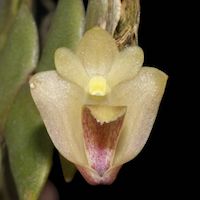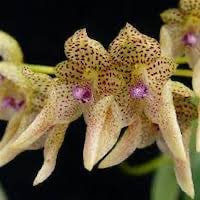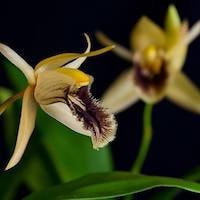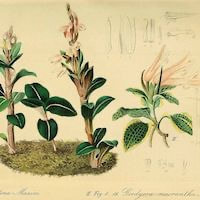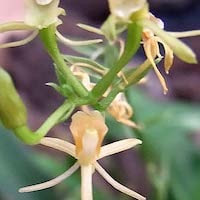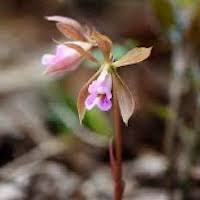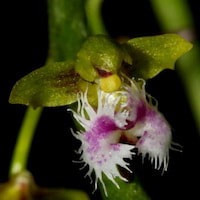Experience the Tranquil Woody Essence of Women Fragrance Oil Woody 3
The fragrance composition includes scented notes from various orchid species with unique characteristics and herbal usages. Dendrobium Leonis, a native Singaporean orchid, features pale green or yellow petals and a sweet, vanilla-like fragrance. It is used in a team-building perfume workshop and is also known for its medicinal properties in treating headaches.
Bulbophyllum umbellatum, found in the western Himalayas and Thailand, contains cirrhopetalanthrin and is utilized in Ayurvedic preparations for promoting longevity. Coelogyne ovalis Lindl., known as Changlinbeimu Lan in Chinese and Jeevanti in Indian, contains several beneficial molecules and is used as a tonic and for treating coughs, urine infections, and eye disorders.
Goodyera biflora (Lindl.) Hook f. Syn. Goodyera pauciflora Schltr., a small terrestrial orchid, is distributed across various regions and is used for detoxification, treating tuberculosis-related symptoms, and alleviating snake bites, sores, and ulcers. Liparis petiolata (D. Don) P.F. Hunt & Summerh., known as Bingyeyangersuan in Chinese, offers lung-beneficial properties and is found in several regions.
Nervilia plicata (Andr.) Schltr. Syn. Nervilia purpurea (Hay.) Schltr., known as Maoyeyu Lan and Qingtiankui in Chinese, grows in forests across Southeast Asia and Australia. It contains alkaloids and is used to clear the lungs, relieve coughs, and alleviate pain. Ornithochilus difformis (Wall ex Lindl.) Schltr. Syn. Ornithochilus fuscus Wall ex Lindl., known as Yixingxiachun Lan in Chinese and Soi Thong in Thai, is widely distributed from the Himalayas to southern China. It is used to treat rheumatism, arthritis, and soft tissue trauma.
The fragrance composition also includes additional scent notes such as smoky, woody, sweet, balsamic, and resinous aromas, complemented by hints of herbaceous woods like Belambra tree, Larch, Neem, and Muhuhu.
Bulbophyllum umbellatum, found in the western Himalayas and Thailand, contains cirrhopetalanthrin and is utilized in Ayurvedic preparations for promoting longevity. Coelogyne ovalis Lindl., known as Changlinbeimu Lan in Chinese and Jeevanti in Indian, contains several beneficial molecules and is used as a tonic and for treating coughs, urine infections, and eye disorders.
Goodyera biflora (Lindl.) Hook f. Syn. Goodyera pauciflora Schltr., a small terrestrial orchid, is distributed across various regions and is used for detoxification, treating tuberculosis-related symptoms, and alleviating snake bites, sores, and ulcers. Liparis petiolata (D. Don) P.F. Hunt & Summerh., known as Bingyeyangersuan in Chinese, offers lung-beneficial properties and is found in several regions.
Nervilia plicata (Andr.) Schltr. Syn. Nervilia purpurea (Hay.) Schltr., known as Maoyeyu Lan and Qingtiankui in Chinese, grows in forests across Southeast Asia and Australia. It contains alkaloids and is used to clear the lungs, relieve coughs, and alleviate pain. Ornithochilus difformis (Wall ex Lindl.) Schltr. Syn. Ornithochilus fuscus Wall ex Lindl., known as Yixingxiachun Lan in Chinese and Soi Thong in Thai, is widely distributed from the Himalayas to southern China. It is used to treat rheumatism, arthritis, and soft tissue trauma.
The fragrance composition also includes additional scent notes such as smoky, woody, sweet, balsamic, and resinous aromas, complemented by hints of herbaceous woods like Belambra tree, Larch, Neem, and Muhuhu.
Download the guided mediation that works best with this Orchid fragrance oil
| women_woody_essential_oil_orchi_00003.mp3 | |
| File Size: | 163884 kb |
| File Type: | mp3 |
Unlock Therapeutic Serenity with Fragrant Oils
Contains Scented Notes of following in various proportions:
Native Singaporean Orchid notes: Dendrobium Leonis
|
Dendrobium Leonis - Used in Woody 3 (Women) for Team building Perfume workshop
As on Npark's website, it has been noted as a Medicinal (The plant is used to treat headache in Thailand.) Dendrobium Leonis, also known as the Lion's Dendrobium, is an orchid species that is valued for its aromatic properties and has found its place in the fragrance "Woody 3 (Women)" designed for a team-building perfume workshop. This orchid has garnered recognition for its medicinal qualities, particularly in Thailand, where it is employed in the treatment of headaches. The flowers of Dendrobium Leonis are petite, measuring between 1.3 to 2.0cm in size. They showcase delicate pale green or yellow petals, with the lip of the flower exhibiting a very pale green hue that is adorned with a flush of dark purple. Along with their visually appealing appearance, these flowers exude a delightful and sweet fragrance reminiscent of vanilla. The fragrance creators have further identified nuanced notes of chocolate and vanilla, and they liken the overall floral presentation to that of a joyous and playful baby rabbit, evoking a sense of mirth and whimsy. Within the cultural context of Thailand, Dendrobium Leonis is referred to as "Uang takhap yai, kang pla" by the local population. This name reflects the traditional medicinal usage of the orchid in treating headaches and highlights the significance and effectiveness of this orchid species in traditional Thai herbal remedies. |
Therapeutic Orchid notes:
|
Bulbophyllum umbellatum
Bulbophyllum umbellatum, also known as Cirrhopetalum maculosum, is an orchid species that is native to the western Himalayas and Thailand. This orchid species has garnered interest due to its unique fragrance profile. One significant compound isolated from Bulbophyllum umbellatum is cirrhopetalanthrin, which is a dimeric phenanthrene derivative. This compound holds potential therapeutic properties and has been utilized in Ayurvedic preparations under the name "swarna jivanti." Swarna jivanti is valued in Ayurveda for its ability to promote longevity and overall well-being. Additionally, the roots of Bulbophyllum umbellatum are reputed to possess longevity-promoting properties. These roots are esteemed for their potential health benefits and have been traditionally used in various practices to enhance vitality and longevity. The research conducted on Bulbophyllum umbellatum highlights its significance in traditional medicinal practices, particularly in Ayurveda, where it is recognized for its therapeutic properties and its potential to support overall health and longevity. |
|
Coelogyne ovalis Lindl.
Chinese name: Changlinbeimu Lan Indian name: Jeevanti Coelogyne ovalis, also known as Changlinbeimu Lan in Chinese and Jeevanti in Indian culture, is an orchid species that possesses notable scents. This orchid species has been the subject of phytochemical studies, revealing the presence of several beneficial molecules. Some of the identified compounds in Coelogyne ovalis include 2,7-dihydroxy-3,4,6-trimethoxy-9,10-dihydrophenanthrene, coelogin, coeloginin, flavidin, flavidinin, batatasin III, imbricatin, beta-sitosterol and its glycoside, as well as a new bibenzyl compound called 30-o-methylbatatasin III. Among these molecules, flavidin and coelogin have shown spasmolytic activity, specifically inhibiting spasms induced by barium chloride in guinea pigs. Herbal usage of Coelogyne ovalis is extensive, particularly in India where it is known as Jeevanti, meaning "promoting life." In Nepal, the pseudobulbs of this orchid species are regarded as aphrodisiacs, contributing to its name Jeevanti. In western and southern India, it is utilized to treat coughs, urinary infections, and eye disorders. This orchid species is valued for its tonic properties and its application in traditional medicine for various ailments. |
|
Goodyera biflora (Lindl.) Hook f. Syn. Goodyera pauciflora Schltr.
Chinese name: Danhuabanye Lan (Big flower spotted leaf orchid) for Goodyera pauciflora from Sichuan and Yunnan: Shaohuabanye Lan (Few flowered spotted leaf orchid) Goodyera biflora, also known as Danhuabanye Lan in Chinese or Big Flower Spotted Leaf Orchid, is a small terrestrial orchid species with a long creeping rhizome and an erect stem. It is distributed across various regions, including Nepal, Bhutan, India, China (Xizang, Yunnan, Sichuan, Shanxi, Hubei, Hunan, and Guangdong Provinces), as well as Japan and Korea. In traditional Chinese medicine, Goodyera biflora has been utilized for its medicinal properties. The whole plant is used to address haemetemesis associated with tuberculosis, anorexia, and neurosis. It is believed to enrich yin and benefit the lungs. Chinese herbalists employ the entire plant for detoxification purposes and to treat snake bites, sores, and ulcers. Additionally, the leaves have been used in decoctions and externally to treat scrofula, a lymph node condition, in the Americas. The herbaceous nature of Goodyera biflora and its extensive usage in traditional medicine reflect its cultural significance and potential therapeutic value in addressing various ailments. |
|
Liparis petiolata (D. Don) P.F. Hunt & Summerh.
Chinese name: Bingyeyangersuan (handle leaf sheep ear garlic) Liparis petiolata, also known as Bingyeyangersuan in Chinese or Handle Leaf Sheep Ear Garlic, is a terrestrial herb characterized by ovoid pseudobulbs. This species is primarily found near streams at elevations ranging from 1000 to 2900 meters in regions such as Hunan, Jiangxi, Guangxi, southern Yunnan, and southeast Xizang in China. It is also distributed in other countries including Vietnam, Thailand, Bhutan, Nepal, and northeast India. In terms of herbal usage, Liparis petiolata is believed to provide benefits to the lungs. The specific properties and applications of this herb in traditional medicine may vary across different cultures and regions. The recognition of its lung-beneficial properties suggests its potential for respiratory health support in traditional practices. |
|
Nervilia plicata (Andr.) Schltr. Syn. Nervilia purpurea (Hay.) Schltr.
Chinese names: Maoyeyu Lan (hairy leaf yam orchid), Qingtiankui (blue sky sunflower) Chinese medicinal name: Qingtiankui (blue sky sunflower) Note: same name for N. fordii Indian names: Padmacarini (Sanskrit), Oarilai thamarai (in Tamil; vernacular name used by primitive Poliyar tribe) Nervilia plicata, also known as Maoyeyu Lan or Qingtiankui in Chinese, is a fascinating orchid species with rich cultural significance. It is also referred to as Padmacarini in Sanskrit and Oarilai thamarai in Tamil. This orchid grows in deep forests, spanning across regions from Bangladesh, Myanmar, Thailand, northern Peninsular Malaysia, and Indochina to Indonesia, the Philippines, and Australia. In China, it can be found in rocky, humus-rich soil in hilly forests, particularly in southern Gansu, Sichuan, Yunnan, Xizang, Guangxi, Fujian, Guangdong, and Hong Kong. The plant displays distinctive features depending on the light intensity it receives. In dense undergrowth with poor light, the leaves of Nervilia plicata turn deep purple to almost black in color, while in bright greenhouses, the leaves remain green. This orchid has earned the name Padmacarini due to its likeness to the pink lotus, as mentioned in ancient Indian texts. In terms of phytochemistry, N. plicata contains significant amounts of alkaloids. In Traditional Chinese Medicine (TCM), the whole plant is used for its therapeutic properties. It is believed to clear the lungs, alleviate coughs, and remove heat and toxic materials from the body. In Taiwan, it is known as I-tian-hong and is used to treat various conditions such as bruises, weakness, pneumonia, and hypertension. In the Philippines, the leaves of N. plicata are chewed and rubbed on the stomach for pain relief, while an aqueous extract of the leaves is consumed to facilitate childbirth. Nervilia plicata also holds importance in Ayurvedic preparations. It is an ingredient in Priyagvadignana, a formulation mentioned in Vagbhata, and other preparations such as Vastyamayantaka ghratham and Satavari Ghrtam. The mucilaginous extract of the pseudobulb, often combined with turmeric, is used as an infusion to address various ailments, including cough, rheumatism, dysuria, urinary calculi, diabetes, diarrhea, vomiting, jaundice, epilepsy, and illnesses associated with evil spirits. It is considered hot, bitter, and astringent in nature. In the Wayanad district of Kerala in India, N. plicata has been used as a traditional remedy for diabetes. The leaves are prepared into a paste and administered orally to treat skin diseases by the Poliyer tribe, one of the oldest tribal communities residing in the Anaimalai Hills of Tamil Nadu in southern India. |
|
Ornithochilus difformis (Wall ex Lindl.) Schltr. Syn. Ornithochilus fuscus Wall ex Lindl.
Chinese name: Yixingxiachun Lan (unique shape narrow lip orchid), Yuchun lan (feather lip orchid) Thai name: Soi Thong Ornithochilus difformis, also known as Yixingxiachun Lan or Yuchun lan in Chinese and Soi Thong in Thai, is an orchid species with unique characteristics and widespread distribution. It blooms during different periods in various regions: from February to April in the Himalayas, May to July in China, and July in Peninsular Malaysia and Thailand. This orchid species can be found across a wide range, spanning from the tropical Himalayas (Garhwal to Sikkim and Assam) to southern China, including Guangdong, Guangxi, Sichuan, and Yunnan. Its unique floral structure gives rise to its Chinese name "Yixingxiachun Lan," meaning "unique shape narrow lip orchid," and "Yuchun lan," meaning "feather lip orchid." In terms of herbal usage, the whole plant of Ornithochilus difformis is employed in traditional Chinese medicine to address rheumatism, arthritis, sprains, and soft tissue trauma. It is collected from various provinces in China, including Guangdong, Guangxi, Yunnan, and Xizang. Overall, Ornithochilus difformis is a species valued for its unique appearance and therapeutic properties in treating musculoskeletal conditions in traditional medicine practices. |
Other scent note
Smoky, woody, sweet, balsamic, resins with hint of herbaceous woods, Belambra tree, Larch, Neem, Muhuhu
Scentopia Library Reference ingredient
Fiddle Wood - Sentosa's Plants - Check details at Scentopia's scent library
Join Scentopia's wonderful orchid scent crafting, fragrance tour, bridal shower or corporate team building which includes perfume making onsite and offsite, beach activities and more. We also serve primary school learning journey, secondary students and pupil on industrial excursions. Know more about our orchids perfume bar or therapeutic orchid scents and other wellness aromas. Conatct Perfume workshop or book a scent crafting session here.
